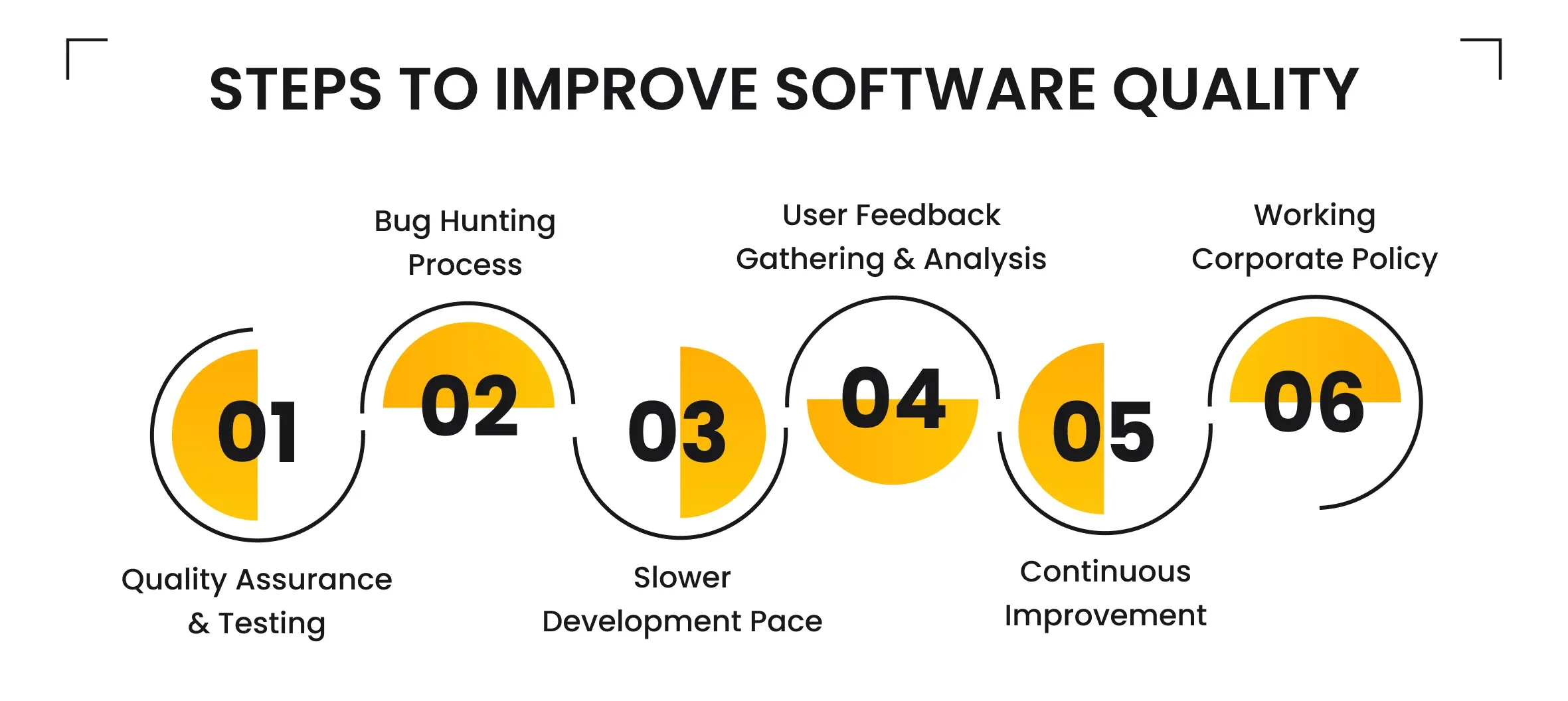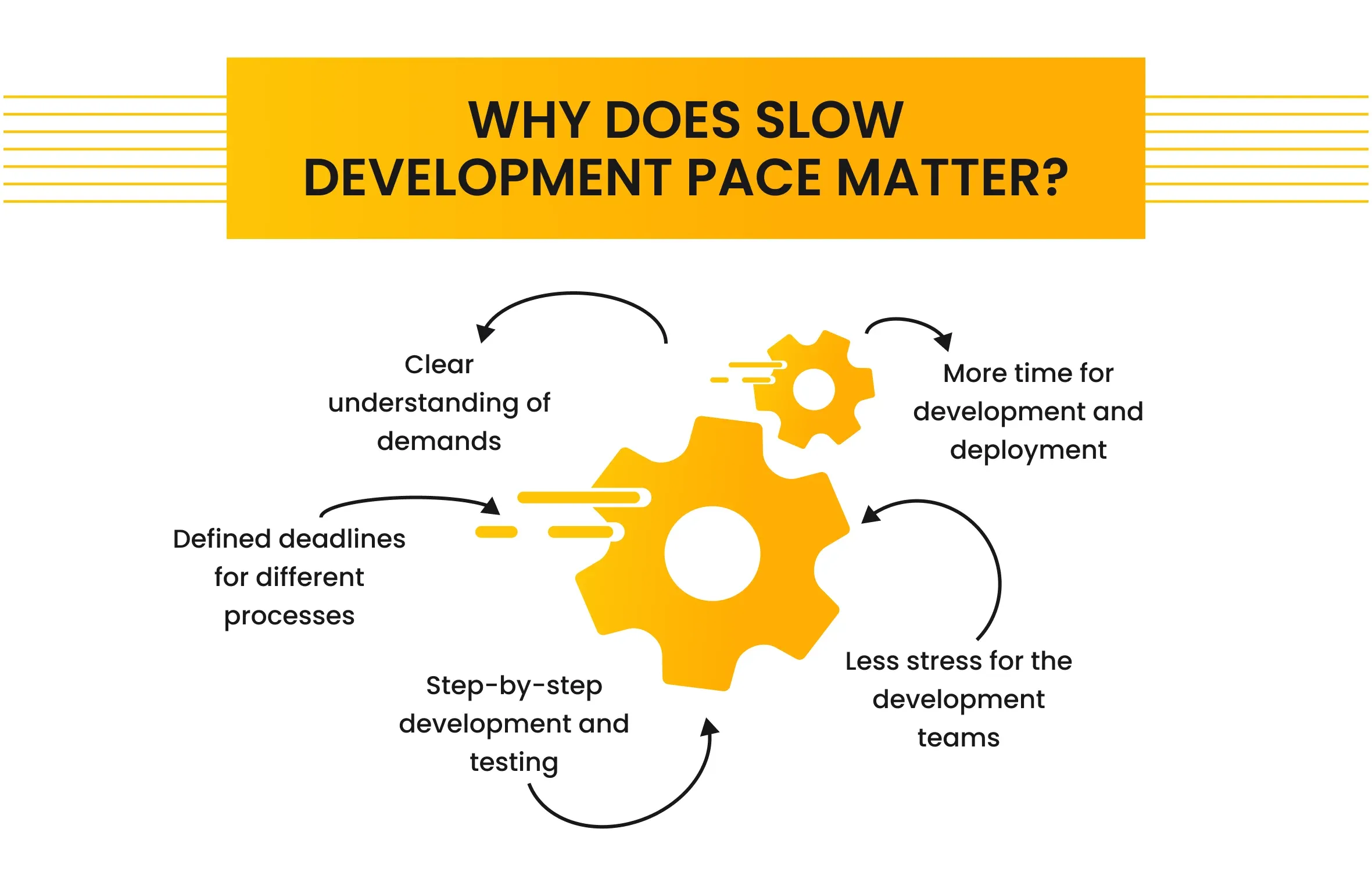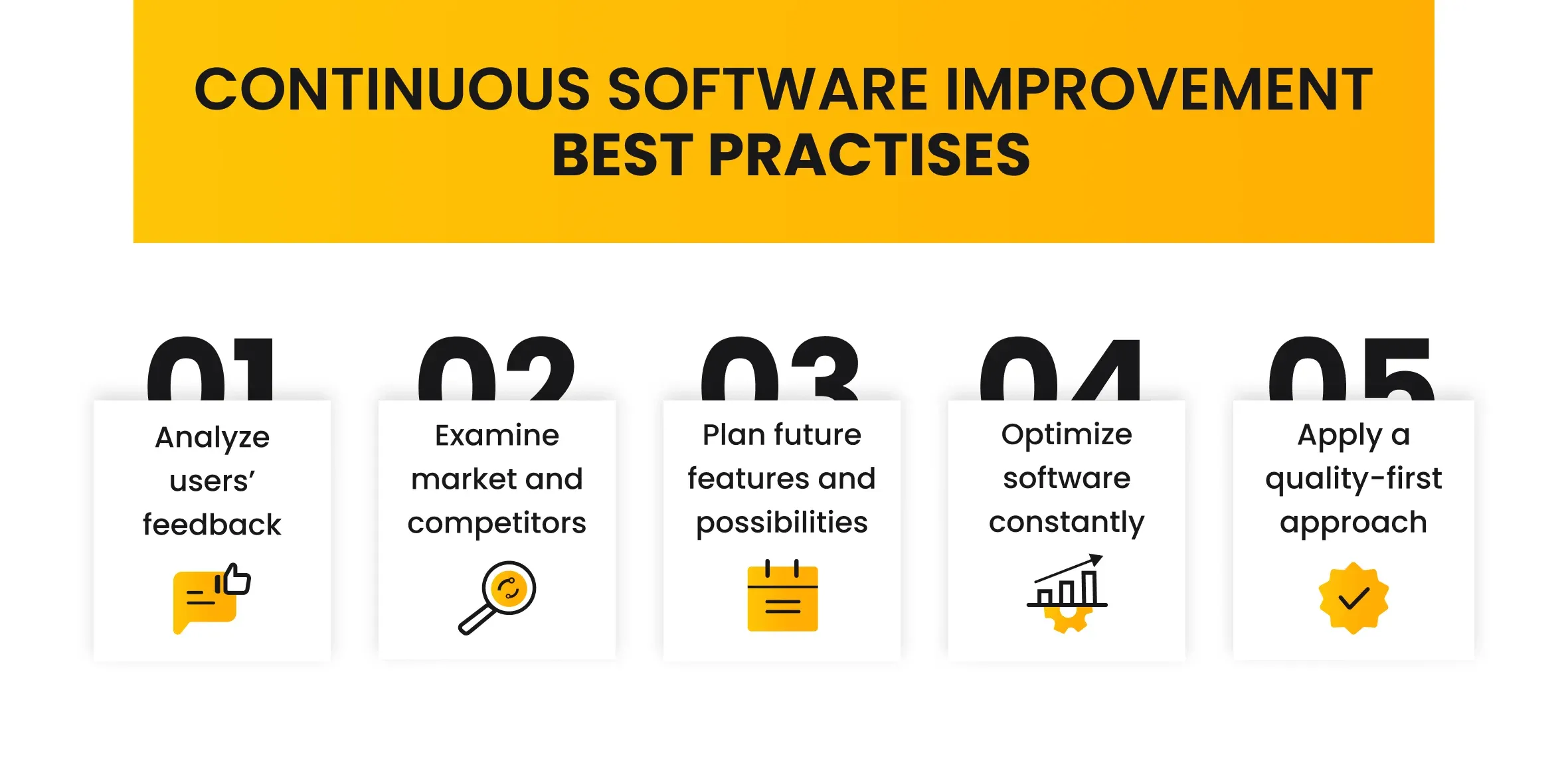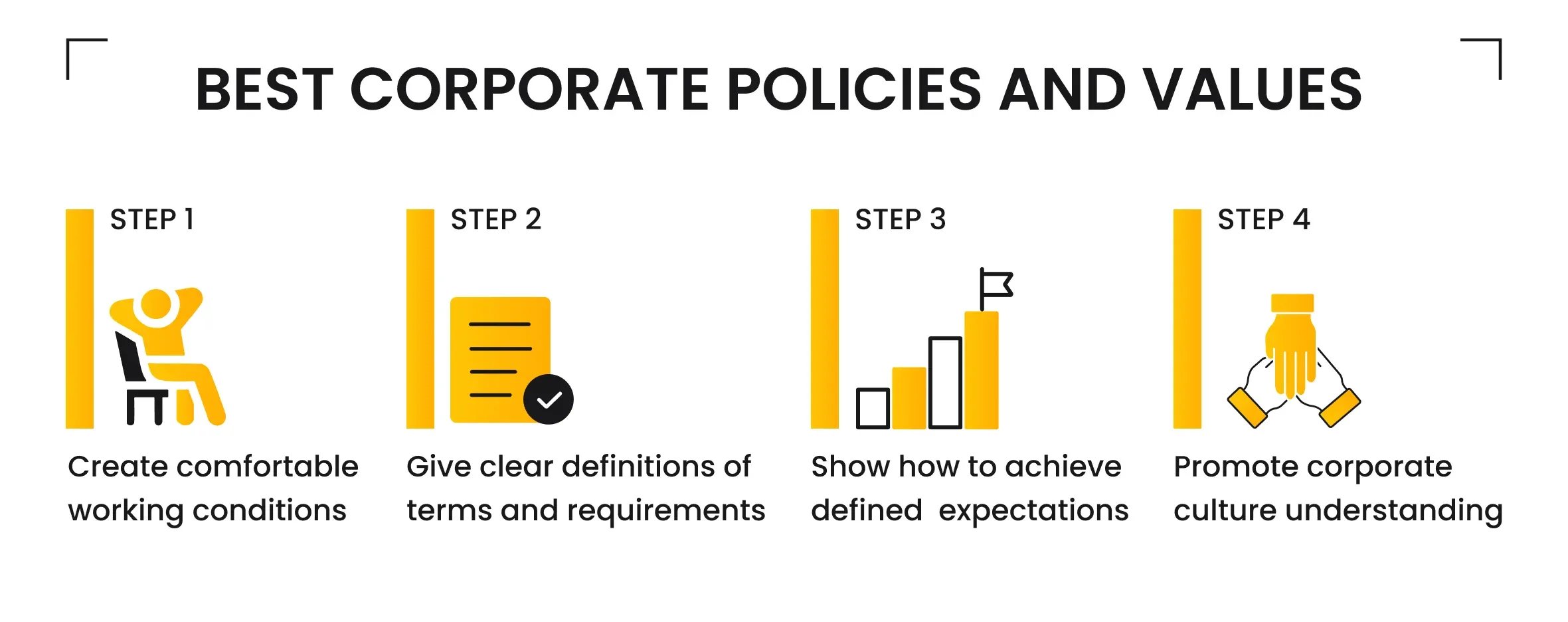How to Improve Software Product Quality in 2024?
November 16, 2022 • 398 Views • 20 min read
Bohdan Vasylkiv
CEO & Co-Founder
Everyone wants to achieve the best software quality possible. At first, this task seems very obvious. Nonetheless, during the software development process, it usually becomes a real headache. Thus, to set priorities, that will help to succeed, we would like to share some experience on how to improve the software quality of the product.
But first, let’s define software quality terms, and the aspects, that impact increasing the quality of the software products.
Definition of Quality in Software Testing
So, what is software quality? Frankly speaking, there are countless theories and interpretations of what software quality in software engineering means and how to achieve it.
The only way to figure out whether software product quality is good or bad - is to find out what the targeted audience thinks of your final project. In other words, the most crucial aspect for understanding the result of your product quality is the user experience and user interfaces, or how seamless and friendly it is to the end-user.
One of the main mistakes made by various software companies is that they usually take care of testing and fixing the occurring bugs, forgetting about the product itself. To make it simple, developers usually care more about the metrics, instead of customer satisfaction.
This doesn’t mean, that nobody cares about the feedback. Still, it is a common mistake to prioritize the optimization of a product over giving demanded answers and fulfilling customer requirements.
It is worth mentioning, that there is no such thing as an “ideal product”, i.e. one, that meets all expectations. So, constant efforts to get rid of all errors will lead to finding new ones.
Still, bug fixing and testing is a must-have process in any software development lifecycle. Still, these are not the only actions, that should be taken care of to ensure software quality in software engineering.
How To Improve Software Quality?

1. Quality Assurance and Testing Process
Quality assurance and the overall testing stage are crucial and must be done in any case.
They are also the most well-known and described procedures for improving the quality of software projects. There are numerous guides and tutorials on “how to perform software testing” and “best QA practices for various projects”. These topics are described in detail, and there is no need to repeat well-known facts. However, if you are looking for more detailed answers - you are welcome to read some of our related articles.
Both testing and QA are performed during the software development cycle. It can be manual and/or automated testing, depending on your needs and available resources.
Manual testing is not as performative as automated in terms of technical review of the software project, i.e. various metrics, bug hunting, KPI, code reviews, logical errors, etc. Manual testing is performed manually by QA specialists and testers. So, it is slower, yet much deeper. Especially, when it comes to understanding UI/UX design quality in software engineering.
At the same time, automated testing actually can’t analyze the UI/UX efficiency and quality. Still, it is more advanced and deals with the code or other functional code-based components much faster.
To sum it up, the quality assurance practice is not to choose between manual or automated testing. If you want to achieve the best results, it is better to combine both software quality testing approaches and use each for tasks, they are suited best:
- Manual testing for certain parts and UI/UX design quality in software engineering
- Automated testing for checking code and various metrics
However, if you have limited resources - you might consider increasing the manual testers team over automated testing tools. Testing automation is commonly resource-intensive and highly depends on software tools, which are usually expensive.
2. Bug Hunting Process
At Incora, we prefer to distinguish bugs from issues. To clarify this statement, we have to explain both terms:
- Issues are something, which results in the incorrect working of the software product. To rephrase it, issues are apparent mistakes or errors within the project, which must be fixed at any rate.
- Bugs, on the other hand, are something, which works not as supposed to. So, in most cases, bugs are working, but not how was planned. As a result, they should not always be fixed - sometimes they can create a prospect for changes and transformation from a bug into a feature.
At first, the difference between these terms may be not obvious. Yet, in practice, it becomes more clear.
This distinction allows us to state, that the bug-hunting process itself must be performed with the involvement of humans, who can recognize the opportunity to transform a bug into a brand-new feature of an application. As a result, you will probably be able not only to fix a bug but to increase the variety of options for the audience. Hence, it will improve the user experience in both scenarios.
3. Slow Down Development Pace

There are countless proverbs and sayings in any society, that recommend avoiding rushing. Why won’t you take your time and develop your product step-by-step?
Do not underestimate the importance of a correct roadmap. It will help you track the progress of the software development cycle at any time, make more precise and adequate deadlines, and prepare your quality and product management process plan.
You don’t need to always slow down the entire process. Instead, it is worth finding a perfect balance between the development pace and quality. If you can ensure the high software quality of the product without impacting the speed - then don’t.
Pay more attention to the planning and discovery phase of the project, especially estimation. This helps to better understand the scale of work and available time for full-fledged development of high-quality software products. Still, do not postpone everything until the last moment. Constant work is so much better approach, even if it can be routine and more moderate.
4. Gather and Analyze User Feedback
A high-quality software product can’t be done without a supporting stage when various updates, extensions, and improvements are implemented.
Don’t forget, that the end-user is the one, who defines whether the software quality is good or bad. This is why it is highly important to regularly check on the reviews and feedback from your targeted audience.
One of the most common mistakes of app developers for hire is not taking the feedback seriously, or even arguing with the users. Both decisions are incredibly harmful to your product and the company’s reputation. Even if you have created a bug-free app with a seamless user experience, that lacks demanded features, or doesn’t meet the expectations of the public - it will be considered as if it was a poor project.
Alternatively, if it is truly unique and important for the users - they will forgive poor optimization and bugs, at least at first. There are numerous examples of such attitudes in various industries. Yet, the most eloquent cases belong to the field of game development.
So, high software quality in software engineering is not always about getting rid of bugs or errors but about satisfying your users. If you managed to succeed in both - congratulations, your product is perfect. However, even in this case, there is at least one “but”.
5. Continuous Software Quality Improvement

Supporting and polishing software quality is a never-ending process.
Yet, there will be a moment, when it is not enough. After some time, app users will want to see new features and options to choose from. Thus, it is better to be prepared and have a plan for how to increase the functionality of the product.
First of all, ask the audience, to learn what the app users' expectations are. At the same time, keep improving the user experience, and optimizing the project software quality. Additionally, you can examine the market trends to learn what additional services your competitors propose, whether there are any innovations in the industry, etc.
For instance, various cryptocurrency marketplaces started developing their own NFT wallets, despite the fact, that there was no actual request from customers. Yet, NFT is a fairly new technology, partly related to cryptocurrency.
So, the will to compete with rivals and to adapt to new tech rapidly changed the market. As a result, all newcomers to the cryptocurrency industry are considering NFT wallets as a must-have feature, despite the fact, that only a few years ago it wasn’t.
Nevertheless, don’t rush into adding numerous features to your product, and remember Occam’s Razor principle. To make it simple, try not to overload your product with minor elements. Instead, try to get rid of unneeded and unused functions. This will simplify the work of the dedicated software development team and result in increasing the quality of the software by better development.
6. Corporate Policy

Last but not least, work on your corporate policy and software quality culture. The better you treat your in-house or remote development team - the better software quality results they will show. No need to explain the overall importance of the corporate policy for each company. Yet, there is one vital and underrated aspect.
One of the main goals of corporate policy - is to improve the performance of your employees and create comfortable working conditions for each employee. It also includes practices for software quality management in software engineering.
For instance, they should clarify the criteria of software quality, include the definition of quality in software testing, and explain how to achieve the best results.
It is essential not only to include these parts in your corporate culture and policies but also to ensure that each app developer for hire understands the significance of this paradigm. This may seem obvious and naive but it really matters and can significantly change the final result.
What are Software Quality KPI Metrics?
Additionally, one of the most important aspects of any software quality assurance is to define correct KPI metrics.
Key performance indicators (KPIs) are used to measure the performance and efficiency of a certain task or process. There are numerous ways how to define and calculate such metrics to better track and monitor your efficiency. Nevertheless, for a better illustration, we propose a short list of possible KPIs to define software quality improvement strategy effectiveness.
- Lead time: it is the time, required to embody the concept into reality. The shorter it is - the better.
- QA velocity: it is defined by the number of tasks or software parts, that can be done by a team in a single run. The more they can achieve - the better.
- Defect density: it is calculated by counting the number of defects or errors in code, or application. You have to choose scale (line of code, code unit, whole module, etc) and count the number of mistakes or other defects in it. Then, you will have to divide your defect count by the size of the chosen scale. The higher the result is - the worse software quality is.
- Defect removal: it is the correlation between the discovered defects before and after the release. To calculate it, you have to divide the number of known and resolved defects by the number of all defects and multiply by 100%. The bigger the result - the better.
- Crash Rate: it is defined by the frequency of app crashes in a certain period. The fewer crashes - the higher the quality.
How to Define Software Quality Assurance Bottlenecks?
Another important aspect that commonly occurs during the software quality assurance process - QA bottlenecks. To simplify it, these are the moments when your quality assurance and improvement cycle stops or slows down at a certain moment.
The number and variety of reasons for bottleneck occurrence is as wide, as with quality assurance KPIs. Yet, we can also name the most common and crucial reasons to start with:
- Poor communication. It is one of the main reasons for bottlenecks in any software development, including QA. To deal with it, you should reconsider how your team communicates internally and externally, change the approaches or messengers, contact forms, etc.
- Lack of required skills. Additionally, it is important to ensure that all your team members have enough skills and documentation, related to the project. Even the best QA specialists might have skill issues when they join new projects. So, pay more attention to onboarding and creating guidelines to navigate the project easier.
- Poor understanding of the roles. It is essential to create a clear understanding of the roles in terms of the project. Thus, to improve software quality management in software engineering - clarify the roles and expectations of each member, and define transparent explanations for each employee.
- Wrong task prioritization and tools. Finally, tracking the priorities and changing them if needed is important. If a new bug or issue is crucial - don’t be afraid to redirect resources for its resolution instead of fixing small errors. Also, don’t forget to use the correct and efficient tools.
Software Quality Management with Incora
One of the best practices of software quality management in software engineering - hiring remote dedicated teams with proven experience, which can be easily checked.
The reason is simple - dedicated development teams have much more experience in working with different technologies, compared with in-house teams. This also includes more experience in defining software quality core aspects and quality assurance routines:
While in-house teams mostly work with the same software product, app developers for hire are constantly engaged in numerous short- and long-term development projects, each of which includes QA steps like performance optimization and bug hunting.
Finally, there is no answer to the question “What is software quality?”. It highly varies, depending on the context of each project and its business logic, main goals to achieve, etc. Thus, dedicated teams from IT vendors like Incora are more flexible and are capable of increasing the quality of the software through better development.
If you want us to define software quality core principles for your software product - contact us, and we will do the rest.
What’s your impression after reading this?
Love it!
2
Valuable
1
Exciting
1
Unsatisfied
1
FAQ
Let us address your doubts and clarify key points from the article for better understanding.
What is software quality?
Software quality refers to the degree to which a software product meets specified requirements, fulfills user expectations, and is free from defects or errors. High-quality software ensures customer satisfaction, reduces maintenance costs, enhances reliability, and fosters trust in the product and its developer.
How can I improve software quality?
You can improve software quality through various practices such as code reviews, automated testing, continuous integration, and adherence to coding standards. For instance, code reviews involve peers examining code changes to identify bugs, improve readability, and ensure compliance with coding standards, thereby enhancing overall software quality.
What are automated tests, and why are they important?
Automated tests are scripts that validate the functionality and performance of software automatically. They help catch bugs early, ensure consistent behavior, and facilitate frequent code changes without introducing regressions.
What is continuous integration (CI) and why is it beneficial for software quality?
Continuous integration involves frequently integrating code changes into a shared repository, followed by automated builds and tests. CI helps identify and rectify integration issues promptly, ensuring a stable and reliable codebase.
you may also like
Let's talk!
This site uses cookies to improve your user experience. Read our Privacy Policy
Accept
Share this article